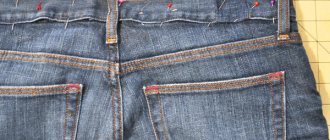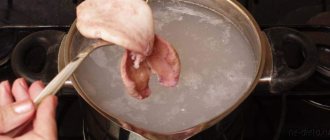When buying new trousers, people often face a trivial problem - their length is longer than necessary for an ideal fit. A universal option for women's, men's and children's clothing - jeans, presented in the most extensive range. Those who have purchased new pants will be interested in learning how to hem jeans using a sewing machine while maintaining the factory seam. Denim items are practical, fashionable, wearable, and therefore are present in every person’s wardrobe. Advice from needlewomen will tell you how to do the job correctly, spending a minimum of time.
Required tools and materials
The decorative seam along the bottom of the legs serves as decoration for the jeans, so when shortening you want to preserve the finish. Before work, you need to remember that an incorrectly measured length of 1-2 cm can disrupt the style of the trousers. To accurately hem jeans, you will need the following tools and materials:
- sewing machine for stitching on thick fabric;
- needles for processing denim material;
- measuring tape, chalk (soap marker);
- tailor's scissors or regular ones with a sharp edge;
- pins, thick threads to match the stitching of the pants;
- threads to match the color of the jeans for unnoticeable hemming.
Experts recommend measuring strictly along the right leg. Then you should carefully align the jeans - lay the item on a flat table surface, fold it inside with the legs, align it along the side seams, belt line, pockets and inner seam. There should be no folds or distortions on the fabric.
How to cut jeans correctly and not disturb the decorative appearance of the bottom of the trousers: first, try on the jeans, mark the hem and tuck them, and try them on again with the shoes. Then the right trouser leg is trimmed, the fitting is performed again and the left trouser leg is shortened. Before making a machine seam, the hem line is basted with contrasting threads.
Ways to hem
To end up with properly hemmed jeans, you need to clearly mark and trim the legs. Two hem widths must be added to the cutting line. Jeans are put on and tried on without shoes, and the unnecessary length of the pants is folded inside and pinned. Use chalk to mark the hem line along the back contour, which should touch the floor. How to roll up and shorten jeans while maintaining the factory hem:
- if you need to hem a women's model with a heel, the jeans are not rolled up to the floor, but slightly longer;
- men's trousers, after preliminary hemming, are tried on again and the hem is adjusted according to the shoe - slightly above the sole;
- narrow women's denim pants are measured taking into account the characteristics of the figure, so that the trouser legs do not bunch up;
- before beautifully folding the jeans, the hem is performed along the back edge, bevelling the front of the legs;
- on the fabric, under the ruler, draw a line parallel to the factory stitching with an allowance of 3-4 cm (double the width of the hem).
If necessary, you need to open the factory seam, remove the threads and carefully smooth the denim material. Having aligned the legs, draw the main shortening line, focusing on the cut leg. When marking, allowance is taken into account. Please note that not all sewing machines can process thick denim. In some cases, you will have to hem the jeans by hand - how to do this carefully is described in the master class. If the machine “takes” thick fabric and rough areas at the seam joints, the work is greatly simplified.
By typewriter
To obtain a beautiful decorative seam, similar to a factory finish, you need to select thick, durable threads of the appropriate shade. It may be difficult to thread the machine needle. Needlewomen advise not to thread thick threads into the machine (unless it is an industrial design with a 150-number needle). You should wind the bobbin with twice the usual thickness of thread using two spools. The tension of the upper thread must be adjusted. How to properly hem jeans on a machine - instructions:
- put on pants, mark the shortening line;
- measure the length of the hem and leave an allowance of 2 cm;
- smooth out the allowances and secure with pins;
- from the wrong side, open the reverse stitch;
- carefully, along the eyelets, pull out the decorative seam;
- thread the removed threads into the machine - needles No. 90,100,110;
- sew a new seam along the wrong side of the trouser leg.
If the product is made of thin fabric, you can hem the jeans yourself without cutting off excess material. Suitable for cases where the hem length is short. After fitting, mark the shortening line, fold the excess fabric inside and make an invisible stitch by hand using short stitches.
If the jeans are made of coarse, dense material, and there are decorative abrasions along the bottom, proceed in the following way: fitting, hemming, shortening the trouser legs with an allowance of 3.5 cm. Then the allowances are smoothed in different directions, overcast by hand, the factory hem is folded, basted and stitched. This is an easy way to shorten jeans while maintaining the frayed edge. On the wrong side, an overcast seam allowance is obtained, but it is possible not to disturb the appearance of the product.
Preserving the factory seam
Jeans look much more beautiful when there is decorative stitching along the bottom of the legs. The easiest way to hem any trousers is to cut off the excess, fold the material twice and machine stitch a new seam. You need to select threads of the appropriate color, but if this is a problem, you can use another way to hem jeans while maintaining the seam:
- put on jeans, put on your shoes and mark the edge of the hem so that there is one to one and a half centimeters to the floor from the shortening line. Then stab;
- move around in your pants - sit down, walk around to accurately mark the cutting line, pin again;
- measure out the excess, for example, 7 cm. Turn the trousers inside out, measure half the length of the hem (3.5 cm) from the bottom to the factory hem;
- measure 3.5 cm (in this case) along the circumference of the trouser leg, pinning with needles or pins;
- sew the jeans along the very edge of the factory hem, measure and cut off the excess from the resulting stitch, leaving 1.5 cm;
- process the edge on the overlocker, turn the jeans inside out and make an invisible seam using threads to match the pants along the edge of the seam allowance, iron.
Cutting the jeans will destroy the factory side seams. They need to be connected carefully and evenly so that the stitches match and the side seam does not move. You need to pay attention to this point so as not to redo everything all over again. Additionally, you can make two stitches on the side seams on the inside of the legs so that the seam allowance does not bend.
If you need to shorten jeans with fringe at the bottom, tucking without cutting off excess fabric will look unsightly. The best option for cutting fringed jeans is to make the decorative decoration yourself. To do this, measure the pants and mark the length of the hem. It must be taken into account that fringe requires a supply of material. The jeans are turned inside out, the hem is cut off and the side seams begin to rip out to the length of the fringe. Next, the transverse threads are pulled out with nail scissors or a thick needle - a beautiful decor is obtained. There are two main options for how to cut jeans and make fringe - with a seam above the decor or without a seam. An inconspicuous stitch above the fringe will prevent the threads from unraveling after wearing and washing the pants.
The craftsmen in the atelier use the simplest option - they cut off the excess fabric and sew the bottom on a machine. You can do this work yourself. Jeans with decorative factory seams look most impressive - they are worth preserving.
How to hem jeans and make scuffs: master class
If you have at least once shortened jeans with your own hands, you have probably encountered the following problem: the finished seam looks flat due to the lack of abrasions. There are different ways to avoid this: for example, you can hem your jeans, keeping the factory seam, or try using some kind of abrasive material like sandpaper. The method described in this master class is slightly different. The abrasions here are imitated using acrylic paint for textiles. This takes a little more time, but the result is good and there is no possibility of damaging the seam, as happens when working with abrasive.
Use acrylic for textiles and a machine needle for denim.
How to shorten jeans and keep the factory seam
You will need:
- jeans;
- fabric scissors;
- chalk;
- ruler;
- tailor's pins;
- a needle for hand sewing and thick strong threads for basting;
- suitable threads for hemming jeans;
- sewing machine;
— needle for a denim machine;
- hammer;
- spray bottle with water;
- acrylic paints for textiles (white, plus paints close to the color of your jeans if you want to further darken the seam area);
- a small flat hard brush;
- polyethylene to protect the work surface.
How to hem jeans by hand with a double stitch forward on the needle
Step 1
Try on the jeans, determine the desired length and put a mark on one of the legs.
Fold the jeans as shown in the photo.
Align the jeans so that they are folded evenly in half, match the edges of the waistband and pin the jeans, securing the top edge.
Straighten the pant legs, align and align the crotch and side seams.
Above the mark, pin the pant legs together. Draw a line at the level of the mark perpendicular to the side seam.
From the drawn line, set aside the distance required for the allowance. We will fold the edge of the trouser leg twice: this distance should be equal to the width of the fold you need x2. In our case, the width of the hem is 1.3 cm, set aside 2.6 cm. Place a mark and at its level draw a line parallel to the first one.
Cut the legs along the bottom line. Remove all pins.
Step 2
Trim the allowances with a corner and trim the thick areas on the seams, as shown in the photo. Be careful: the cut out places can then be hidden with a fold. We do this to reduce the overall thickness of the seam and make it easier for the sewing machine to operate.
If we want to imitate scuffs, it is better not to iron the hems so that the edge does not turn out flat. So we sweep them away. First, turn the edges of the legs inward by 1.3 cm and baste.
Then we turn the edge over again and baste again.
To flatten the thickest areas, tap them with a hammer. This will make it easier to pass them by car.
Sew the hems at a distance of 1-2 mm from the fold.
Step 3
Cover your work surface with plastic and use a spray bottle to wet the bottom of your pant legs. The fabric should not be completely damp, but rather moderately damp.
This step will work for you if you used thread that matches the color of your jeans for the stitching. In our case, the jeans are stitched with dark blue threads, and similar ones are used for stitching along the bottom of the legs. Therefore, dyeing the denim color will not change the color of the stitching. But it will be possible to darken the seam area. Choose colors that match your fabric (I mixed some blue, purple and black paint) and dilute them with water. To be sure, it is better to first test the paint on cut pieces of pants.
Using a brush, apply the diluted paint little by little to the seam area.
Repeat on the inside.
Now you need to let the paint and jeans dry. Wait until it dries, otherwise the result may not be the one we are striving for, since the white and dark paint will mix and may give a dirty tint. To speed up the drying process, you can use a hairdryer.
Step 4
To imitate abrasions, the resulting hem must be gathered up. Use thick, strong double thread and a hand needle. First, place stitches along the line that is used to sew the hem. The stitch length is about 0.5 cm. Do not try to make them even and completely identical. When finished, fasten the thread.
Repeat, this time stitching along the bottom edge of the fold.
It should look something like this:
Step 5
Moisten the bottom of your pant legs again. Prepare white paint. It does not need to be diluted with water. Use a brush to pick up a little paint and remove the excess so that the brush is semi-dry.
Using light movements, move your brush along the protruding areas of the folds. Repeat from the inside out.
Paint the bottom edge the same way.
Then bend the hem slightly inward and brush along the fold.
Let the jeans dry. When the paint has dried, you can remove the basting, evaluate the result and, if necessary, add a little paint (and dry again). Ready.
Master class and photo: Natalya Pykhova
How to repair jeans torn at the knee: master class
How to sew jeans at the waist: master class
How to make jeans soft at home











